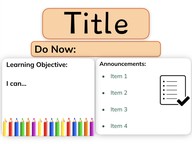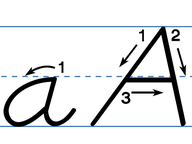
Effective narrative endings
I can identify the ways a narrative can conclude and create my own ending.



8,000 schools use Gynzy
92,000 teachers use Gynzy
1,600,000 students use Gynzy
General
Students will be able to identify the various ways in which effective narratives end. Students will create a mind map in which they discuss the various ways that narratives can end. They will pull information and prior knowledge from books, t.v. shows, or movies they have read/watched. Students will discuss the strengths of each and whether or not they enjoy these types of endings. The narrative endings discussed in this lesson include: resolved ending, unresolved ending, expanded ending, unexpected ending, ambiguous ending, and tied ending. Students will finish the lesson by writing their own ending to a short story, All Summer in a Day by Ray Bradbury.
Standards
CCSS.ELA-Literacy.W.6.3e
CCSS.ELA-Literacy.W.7.3e
CCSS.ELA-Literacy.W.8.3e
Learning Objective
Students will be able to identify(recognize) the different ways a narrative can conclude and create their own ending to a story.
Introduction
Students will brainstorm the different ways a story can end. They will think back to a book or a few of the books you’ve recently read. How did it end? Did you like the ending(s)? Why or why not?
Instruction
Ask your students to construct a mind map. Here are the directions: 1) Write all the types of narrative endings you know and describe them. 2) What effect does each narrative ending have on readers? 3) Do you like/dislike endings? Why? Students will brainstorm and write down some of the different types of narrative endings they know on a mind map. “Narrative Endings” will be at the center of the mind map. Students should be directed to add branches that describe the diverse types of narrative endings they know. Then, students will be encouraged to add sub-branches in which they describe each ending, their feelings towards it, and examples of texts that include that specific type of ending. One branch is already modeled for the students.
Then, students will learn about the six ways in which narratives end. These include a resolved ending, an unresolved ending, an expanded ending, an unexpected ending, an ambiguous ending, and a tied ending. Students should add to their mind map if any of these endings were missed initially. Were any of these types of endings missed on the mind map? Can we think of any stories that have these types of endings? Let’s add to the mind map. The teacher should look up the following short story (it is not linked in the lesson): All Summer in a Day by Ray Bradbury. After reading, identify and discuss the type of ending Bradbury wrote in All Summer in a Day. The teacher will direct students to refer back to the mind map. They will quickly review the different types of narrative endings as a class, and then each student will determine which type of ending they will invent.
Quiz
Students respond to ten mixed quiz questions. These include rearranging letters, true/false, multiple-choice, and drag and sort.
Closing
Review what you’ve learned, and have students write their own narrative ending to All Summer in a Day by Ray Bradbury. Students should share their writing and discuss the kind of alternative ending they chose to create.
Teaching tips
This lesson includes a lot of space for discussion and reading. Encourage your students to read out the slides. We learn through discussion and ideas are discovered that may not have come to mind.
Instruction materials
- All Summer in a Day by Ray Bradbury
The online teaching platform for interactive whiteboards and displays in schools
Save time building lessons
Manage the classroom more efficiently
Increase student engagement
Discover more!
About Gynzy
Gynzy is an online teaching platform for interactive whiteboards and displays in schools.
With a focus on elementary education, Gynzy’s Whiteboard, digital tools, and activities make it easy for teachers to save time building lessons, increase student engagement, and make classroom management more efficient.



